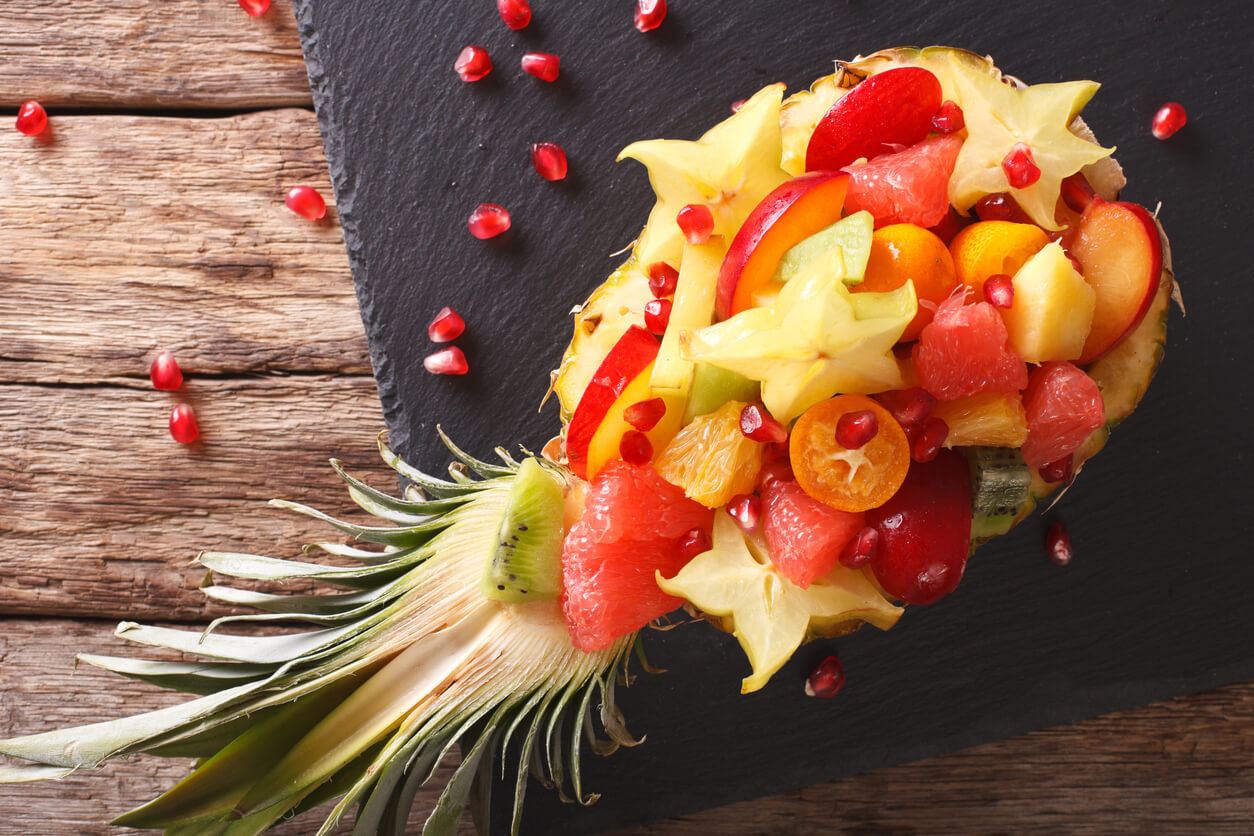2 Pineapple Recipes Your Kids Will Love

Pineapple recipes are ideal to increase the presence of quality antioxidants and vitamins in the diet. This will contribute to improving the functioning of the body and preserve its health. However, to get the most out of these foods, they should be included in the context of a balanced and varied diet.
Before starting, it’s important to note that regular consumption of fruits and vegetables is recommended by almost all nutrition experts. In addition, it’s a good idea to prioritize the intake of seasonal vegetables, as their organoleptic characteristics will be better, as well as their nutritional power.
Ready to cook something tasty and fresh? Take note!
1. Pineapple stuffed with fruit and yogurt

Ingredients
- 1 large pineapple
- Grapes
- 1 mango
- 1 watermelon
- 3 oranges
- Strawberries
- 1 plain yogurt
- 2 tablespoons sugar (optional)
- Mint leaves
Step by step instructions
- Cut the pineapple in half and then extract the pulp.
- Wash the rest of the fruits and peel them into pieces. In the case of the orange, also remove the white part of the interior so that they don’t spoil the dessert.
- Beat the pineapple pulp with a blender with a little water and add two tablespoons of sugar if it’s not too sweet.
- Then, mix the juice with the chopped fruit and stir.
- Fill the inside of the hollowed-out pineapples with the mixture and then add the yogurt.
- Chill the dessert in the refrigerator for a few minutes and place some mint leaves on top when serving.
Why incorporate this recipe into a child’s diet?
This is an excellent alternative to top off a main meal. Not only does it improve the digestive process, but it also provides very high-quality nutrients. For example, vitamin C, a substance that has been shown to be essential for boosting immune function.
2. Pineapple Carpaccio with ice cream

Ingredients
- 1 pineapple
- 200 grams of strawberry
- 30 milliliters of lemon juice
- 175 grams of sugar
- 1/2 teaspoon vanilla sugar
- Vanilla ice cream
Step by step instructions
- Cut the ends of the pineapple and then the pulp into slices. The juice should be set aside.
- Wash the strawberries, remove the stems, cut them into slices, and save the juice aside.
- Arrange them over the pineapple and heat everything in a saucepan together with the lemon juice, the sugar, and the remaining juice of the fruits. It may be necessary to add 100 milliliters of water.
- Pour the syrup over the cut fruits and dilute everything well.
- Let the result cool in the refrigerator and accompany it with a scoop of ice cream when serving. You can even decorate it with chocolate chips.
Considerations when incorporating this recipe into children’s diets
Sometimes it’s good to enjoy a sweeter option after a special meal and the preferred alternatives are whole fruit or yogurt, for their fiber and probiotic content. However, occasionally resorting to other sweet preparations doesn’t carry significant health risks.
On the contrary, when high consumption of simple sugars becomes a habit, the chances of developing metabolic diseases, such as type 2 diabetes, increase. As described in a study published in the journal Current Diabetes Reports.
Prepare pineapple recipes for children
As you’ve seen, there are many alternatives to prepare pineapple recipes and increase the nutritional density of the diet. This way, you can guarantee an optimal supply of antioxidants and vitamins in the body of children, which will result in health improvements in the medium term.
Of course, don’t forget that variety is very important and that other types of fruit should be included in the diet as well.
Pineapple recipes are ideal to increase the presence of quality antioxidants and vitamins in the diet. This will contribute to improving the functioning of the body and preserve its health. However, to get the most out of these foods, they should be included in the context of a balanced and varied diet.
Before starting, it’s important to note that regular consumption of fruits and vegetables is recommended by almost all nutrition experts. In addition, it’s a good idea to prioritize the intake of seasonal vegetables, as their organoleptic characteristics will be better, as well as their nutritional power.
Ready to cook something tasty and fresh? Take note!
1. Pineapple stuffed with fruit and yogurt

Ingredients
- 1 large pineapple
- Grapes
- 1 mango
- 1 watermelon
- 3 oranges
- Strawberries
- 1 plain yogurt
- 2 tablespoons sugar (optional)
- Mint leaves
Step by step instructions
- Cut the pineapple in half and then extract the pulp.
- Wash the rest of the fruits and peel them into pieces. In the case of the orange, also remove the white part of the interior so that they don’t spoil the dessert.
- Beat the pineapple pulp with a blender with a little water and add two tablespoons of sugar if it’s not too sweet.
- Then, mix the juice with the chopped fruit and stir.
- Fill the inside of the hollowed-out pineapples with the mixture and then add the yogurt.
- Chill the dessert in the refrigerator for a few minutes and place some mint leaves on top when serving.
Why incorporate this recipe into a child’s diet?
This is an excellent alternative to top off a main meal. Not only does it improve the digestive process, but it also provides very high-quality nutrients. For example, vitamin C, a substance that has been shown to be essential for boosting immune function.
2. Pineapple Carpaccio with ice cream

Ingredients
- 1 pineapple
- 200 grams of strawberry
- 30 milliliters of lemon juice
- 175 grams of sugar
- 1/2 teaspoon vanilla sugar
- Vanilla ice cream
Step by step instructions
- Cut the ends of the pineapple and then the pulp into slices. The juice should be set aside.
- Wash the strawberries, remove the stems, cut them into slices, and save the juice aside.
- Arrange them over the pineapple and heat everything in a saucepan together with the lemon juice, the sugar, and the remaining juice of the fruits. It may be necessary to add 100 milliliters of water.
- Pour the syrup over the cut fruits and dilute everything well.
- Let the result cool in the refrigerator and accompany it with a scoop of ice cream when serving. You can even decorate it with chocolate chips.
Considerations when incorporating this recipe into children’s diets
Sometimes it’s good to enjoy a sweeter option after a special meal and the preferred alternatives are whole fruit or yogurt, for their fiber and probiotic content. However, occasionally resorting to other sweet preparations doesn’t carry significant health risks.
On the contrary, when high consumption of simple sugars becomes a habit, the chances of developing metabolic diseases, such as type 2 diabetes, increase. As described in a study published in the journal Current Diabetes Reports.
Prepare pineapple recipes for children
As you’ve seen, there are many alternatives to prepare pineapple recipes and increase the nutritional density of the diet. This way, you can guarantee an optimal supply of antioxidants and vitamins in the body of children, which will result in health improvements in the medium term.
Of course, don’t forget that variety is very important and that other types of fruit should be included in the diet as well.
All cited sources were thoroughly reviewed by our team to ensure their quality, reliability, currency, and validity. The bibliography of this article was considered reliable and of academic or scientific accuracy.
- Carr, A. C., & Maggini, S. (2017). Vitamin C and Immune Function. Nutrients, 9(11), 1211. https://doi.org/10.3390/nu9111211
- Yoshida, Y., & Simoes, E. J. (2018). Sugar-Sweetened Beverage, Obesity, and Type 2 Diabetes in Children and Adolescents: Policies, Taxation, and Programs. Current diabetes reports, 18(6), 31. https://doi.org/10.1007/s11892-018-1004-6
This text is provided for informational purposes only and does not replace consultation with a professional. If in doubt, consult your specialist.








